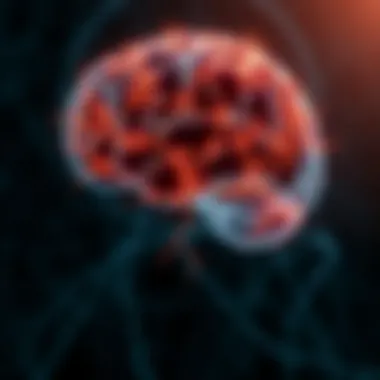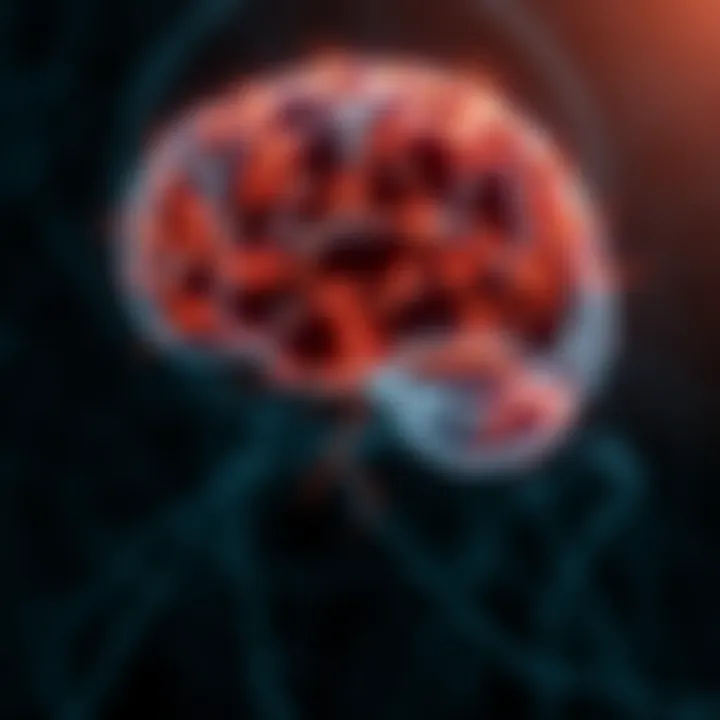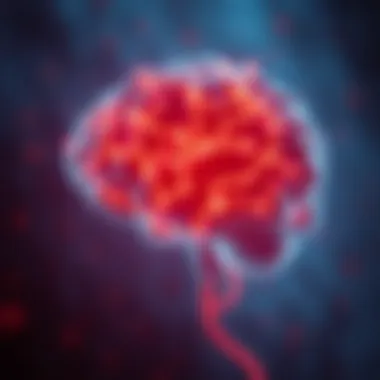Understanding Emotional Seizures: Emotion and Neuroscience


Intro
Navigating the complex landscape of emotional health requires an in-depth understanding of mental well-being and the ways in which it intertwines with neuroscience. Emotional seizures represent a fascinating intersection of these fields, offering insight into how our emotional responses can manifest physically in the brain. By dissecting this concept, we not only grasp the implications of emotional seizures but also link emotional states with neurological processes more broadly. This discussion encompasses the definition of emotional seizures, causal factors, their psychological ramifications, and most importantly, ways to cope with and understand these experiences.
Understanding Mental Health and Well-being
What is Mental Health?
Mental health encompasses emotional, psychological, and social well-being. It shapes how we think, feel, and act. Furthermore, it influences how we handle challenges, relate to others, and make choices. Indeed, mental health is vital at every stage of life, from childhood and adolescence through adulthood. Often, we gloss over the significance of mental well-being, treating it like an afterthought. Yet, it is as crucial as physical health, if not more so.
The Importance of Prioritizing Mental Well-being
Choosing to prioritize mental well-being can alter the course of one’s life drastically. Just as we wouldn't ignore a physical ailment, it is wise to address mental health concerns with the same urgency. When neglected, these concerns can escalate into serious issues, affecting relationships, job performance, and overall life satisfaction. Cultivating habits that support mental health ultimately creates a robust foundation for resilient living.
Common Mental Health Challenges and Disorders
Countless individuals grapple with a variety of mental health challenges. Depression, anxiety disorders, and post-traumatic stress disorder are just a few of the common issues. Each condition manifests uniquely, affecting not only individual sufferers but also those around them. Understanding these conditions helps break the stigma and encourages people to seek help when necessary.
Strategies for Improving Mental Health
Self-care Techniques and Practices
Self-care stands as a pivotal practice for anyone wishing to foster mental well-being. Engaging in activities that promote relaxation and joy can create a buffer against stress. Consider the following methods:
- Physical exercise: Engaging in regular activity boosts endorphins, improving mood.
- Mindful practices: Simple practices like deep breathing or yoga foster calmness.
- Set personal goals: Achieving small, doable aims can provide a sense of accomplishment.
Building Resilience and Stress Management
Resilience is essential for overcoming life’s hurdles. Learning to adapt and bounce back from setbacks forms a core aspect of mental health. One effective method of building resilience involves developing a support network. Whether family, friends, or a professional group, having people to lean on provides a safety net during tough times. Additionally, regularly practicing stress management techniques helps alleviate pressure before it builds.
Seeking Professional Help: Therapy and Counseling
When challenges become too overwhelming, seeking professional help is a brave step. Therapy serves as a powerful tool in understanding and combating various emotional difficulties. Mental health professionals provide a safe space to explore feelings and develop coping strategies. For those with emotional seizures, therapy can also unravel the connection between emotions and neurological responses, leading to greater control and understanding.
Finding Balance in Life
Healthy Lifestyle Choices: Diet, Exercise, and Sleep
Maintaining balance in life is often about making healthy lifestyle choices. Nutrition plays a significant role, as certain foods can enhance mood and cognitive function. Regular physical activity not only contributes to physical fitness but also improves mental clarity. Prioritizing sleep is equally important; genuine rest rejuvenates the mind and allows effective emotional regulation.
Mindfulness and Meditation Practices
Mindfulness practices, including meditation, allow individuals to become more aware of their thoughts and emotions. These practices cultivate a non-judgmental awareness of the present moment, reducing anxiety and promoting emotional balance. Just a few minutes a day can bring significant changes to one’s mental state.
Setting Boundaries and Managing Time Effectively
Life can quickly become overwhelming without clear boundaries. Learning to say no can free up time for self-care and personal interests. Effective time management can also alleviate stress and enhance productivity. Structuring your day to include both work and leisure is an essential skill that contributes to overall well-being.
Enhancing Personal Development
Goal Setting and Productivity Tips
Establishing goals fosters a sense of direction. Goals serve as motivation and help individuals focus their efforts. Whether professional aspirations or personal growth, crafting clear, achievable goals is vital. Use the SMART criteria—Specific, Measurable, Achievable, Relevant, and Time-bound—to create practical objectives.
Building Healthy Relationships and Social Connections
Human connections significantly affect our mental health. Building healthy relationships promotes happiness and serves as a buffer against stress. Engage in social activities, nurture partnerships, and foster a sense of belonging. Meaningful connections can alleviate the isolation often felt by those experiencing emotional seizures.
Practicing Gratitude and Positivity
Focusing on gratitude can shift one’s mindset from scarcity to abundance. Maintaining a gratitude journal can help individuals appreciate positive aspects of life, which can mitigate feelings of negativity and hopelessness. Cultivating positivity is a deliberate choice, contributing profoundly to mental wellness.
Tips for Maintaining Mental Well-being
Strategies for Preventing Burnout
Burnout is all too common in our fast-paced lives. To prevent it, individuals should regularly assess their workloads and emotional states. Taking breaks when necessary and engaging in fulfilling activities can rejuvenate the mind.
Coping with Challenges and Setbacks
Life is unpredictable, and challenges are inevitable. Developing strategies to cope with setbacks is crucial. Recognizing that failure is part of growth can change perspectives and promote resilience.
Creating a Supportive Environment
Finally, cultivating a supportive environment—be it at home or work—enhances mental well-being. Surrounding oneself with positivity and understanding can create a buffer against stressors. This supportive structure is particularly essential for those navigating the complexities of emotional seizures.


Intro to Emotional Seizures
In exploring the topic of emotional seizures, one must first grasp its significance in today’s fast-paced world. Emotional seizures represent a delicate interplay between neurological conditions and emotional states, making them a fascinating subject. Understanding this intersection can have profound implications for both mental health and emotional wellbeing. By being aware of what emotional seizures are, including their manifestations and triggers, individuals may cultivate a better understanding of their own emotional experiences and reactions. This knowledge ultimately paves the way for enhanced strategies in managing mental health issues, fostering resilience, and promoting wellness.
Defining Emotional Seizures
At its core, emotional seizures can be viewed as intense, often overwhelming bursts of emotion that disrupt a person’s mental state as suddenly as a physical seizure can affect the body. Instead of convulsions, these emotional responses may manifest as extreme sadness, anger, or anxiety that may appear without warning. The term refers to emotional experiences that feel as if they have taken control, often leaving individuals questioning their mental stability. While not recognized as a formal medical condition in many diagnostic manuals, the phenomenon resonates deeply with those who experience it, as it encapsulates the chaotic nature of human emotion.
The brain plays a central role in these responses. Various neurological factors contribute to emotional seizures, including how neurotransmitters function and how our brain circuits react to different stimuli. As people navigate their day-to-day lives, understanding the definition and nature of emotional seizures becomes increasingly important, particularly for those looking to support loved ones or seek help themselves.
Historical Context
Historical understanding of emotional disturbances has myriad roots, with some of the earliest references dating back to ancient times. Philosophers and early medical practitioners speculated on the relationship between mind and emotions, often attributing emotional upheaval to external forces or imbalances within the body. Fast-forward to the 19th century, where thinkers like Sigmund Freud began to delve into the depths of human emotion and psychology, marking a significant shift in the understanding of mental phenomena.
The 20th century saw a surge in psychological research contributing additional layers of understanding about emotional processes. Concepts such as emotional dysregulation began to emerge, pinpointing how individuals experience and manage their feelings. With the advancement of neuroscience in the late 20th and early 21st centuries, it became clear that the nervous system plays a pivotal role in regulating emotions, although emotional seizures have not been distinctly classified in broader psychiatric frameworks.
In recent years, heightened attention to mental health issues has led to a deeper conversation about how emotional responses relate to brain function. The ongoing interplay between psychological theory and neuroscience continues to shape our knowledge, paving a way toward better definitions and treatment frameworks for those who live with emotional seizures. Understanding this historical context illuminates the complexities facing individuals and practitioners alike in navigating the emotional landscape.
The Neuroscience Behind Emotional Seizures
Understanding the neuroscience behind emotional seizures is crucial for grasping how emotions and neurological processes interplay within our minds. This comprehensive analysis not only sheds light on the mechanisms behind these phenomena but also embraces how they can affect one’s holistic well-being. By unraveling the intricacies of brain activity during emotional seizures, we gain insights into potential treatment paths and strategies for better mental health management.
Brain Mechanisms Involved
The brain is a complex network, where various structures work in tandem to regulate emotions and responses. When one experiences an emotional seizure, it’s not merely a runaway emotion; instead, it’s accompanied by distinct neural patterns. Studies show that areas such as the amygdala, which processes emotions like fear and pleasure, become hyperactive.
- The Amygdala: This almond-shaped cluster plays a central role in triggering emotional responses. Imagine it as the gatekeeper of our feelings. In heightened states, it can send our brain into a whirl, leading to unwarranted emotional explosions.
- The Hippocampus: Responsible for memory formation, it is also crucial in linking past emotions to present responses. When one is bombarded by overwhelming feelings, the hippocampus may misfire, leading to distress that feels disproportionate.
- The Prefrontal Cortex: This region helps regulate emotions and decision-making. During an emotional seizure, its functions might be impaired, causing individuals to react impulsively, often without the ability to rein in profound feelings.
It’s like a finely-tuned orchestra losing its rhythm, resulting in disarray and unclear signals traveling through the body. Understanding how these brain regions interact offers a roadmap for identifying emotional seizures when they occur and addressing the underlying causes.
Neurotransmitters and Their Roles
Neurotransmitters, the chemical messengers in the brain, are pivotal in shaping our emotional landscape. They determine how we feel, react, and ultimately cope with situations. Certain neurotransmitters play key roles during emotional seizures. Here are some that deserve a closer look:
- Serotonin: Often dubbed the "feel-good hormone," serotonin regulates mood and anxiety. Low levels can lead to feelings of despair, which can exacerbate emotional seizures, making it essential to maintain a healthy balance.
- Dopamine: This neurotransmitter fuels motivation and pleasure. In the throes of an emotional seizure, dopamine levels may fluctuate unpredictably, leading to manic-like emotional states or, conversely, deep lows that can feel overwhelming.
- Norepinephrine: This is the body's natural alarm system, kicking in during stressful situations. As norepinephrine ramps up, so does the intensity of emotional responses, making control difficult in the heat of the moment.
Understanding how these neurotransmitters function, and their relationship with emotional seizures, shines a light on possible therapeutic interventions. Managing neurotransmitter levels through lifestyle changes or medication could pave the way toward greater emotional regulation.
Emotional seizures are not isolated incidents; they reflect the intricate connections between our brain chemistry and emotional experiences.
To summarize, the neuroscience surrounding emotional seizures encompasses the interaction between various brain mechanisms and neurotransmitters. By dissecting these elements, one can better appreciate the interplay of emotions within the neurobiological framework, potentially guiding appropriate coping mechanisms and therapeutic strategies.
Identifying Emotional Seizures
Understanding emotional seizures is essential for recognizing their impact on individuals and their overall mental well-being. These occurrences do more than just disrupt an individual in the moment; they can shape long-term emotional health. By honing in on how to identify them, we can empower people with the knowledge to manage their experiences effectively. Identifying emotional seizures isn't merely an academic exercise; it has practical implications that extend into therapeutic settings and daily life.
Common Symptoms
Emotional seizures can manifest in various ways, often triggered by intense emotional experiences. The symptoms are not uniform and can differ depending on the individual's unique neurological makeup. Common signs include:
- Extreme emotional shifts: A person might transition from calm to severe distress within moments.
- Physical manifestations: These may involve shaking, sweating, or even feeling faint.
- Cognitive disruptions: Individuals might experience confusion or a sense of detachment from reality during these episodes.
A hallmark of these seizures is that they occur in connection with emotional stimuli, indicating a strong link between one's emotional state and brain activity. For some, it’s like flipping a switch; one minute you feel fine, and the next, you're caught in a whirlwind of sensations. As these experiences pile up, they can create anxiety about future episodes, forming a cycle that can worsen mental health if left unaddressed.
Differentiating from Other Conditions
Differentiating emotional seizures from other psychological conditions is crucial for effective treatment and management. While they may mimic symptoms of various disorders, such as anxiety or panic attacks, there are key differences.
- Anxiety attacks typically have a gradual buildup, whereas emotional seizures can surface abruptly.
- Panic disorder is often accompanied by specific fears or phobias, but emotional seizures may not have identifiable triggers.
- Mood disorders tend to display consistent patterns over time, whereas emotional seizures are episodic and can be sporadic.
Understanding these distinctions can aid mental health professionals in crafting tailored treatment plans. For instance, approaches that prioritize emotional regulation techniques may be more beneficial for someone experiencing these seizures compared to other conditions where cognitive behavioral therapy might be effective.
In summary, identifying emotional seizures is an important step in recognizing the profound interplay between emotions and neurological responses. By learning to spot the symptoms and distinguish these episodes from similar conditions, both individuals and health professionals can take a more informed approach, ultimately leading to more effective management strategies.
Triggering Factors
Understanding the triggering factors of emotional seizures is essential for identifying their root causes and managing their impact on individuals. These factors encompass a range of emotional and environmental elements that can precipitate these episodes. By dissecting both emotional triggers and environmental influences, we can better grasp how various stimuli can lead to these intense emotional experiences.
Emotional Triggers
Emotional triggers are personal, often tied to individual histories, experiences, and sensitivities. For many, an emotional seizure might be sparked by seemingly innocuous events or stimuli that hit too close to home.
- Personal Loss: The memory of a loved one lost may evoke a profound sense of mourning that cascades into an emotional seizure.
- Stressful Situations: Events like job loss or relationship issues can push an individual over the edge. Even minor stressors, when accumulated, may lead to a breakdown.
- Rejection or Criticism: A harsh word from a friend or colleague can feel like a dagger, unleashing a torrent of emotions.
- Past Trauma: Memories of traumatic events can resurface without warning, flooding a person with feelings of fear and helplessness.
These emotional triggers can vary widely from person to person, illustrating how unique emotional experiences are. In recognizing these triggers, individuals can learn to anticipate and manage their emotional responses.


Environmental Influences
The environment also plays a pivotal role in triggering emotional seizures. Differences in surroundings can amplify emotional experiences, causing reactions that may not be as pronounced in more neutral settings.
- Social Settings: Crowded spaces or high-stimulation environments like malls or concerts can overwhelm someone already sensitive to sensory input.
- Seasonal Changes: Some individuals may experience emotional fluctuations with the changing seasons, known as Seasonal Affective Disorder (SAD), triggering greater emotional responses.
- Cultural Contexts: Certain cultures may idolize emotional restraint, making it difficult for individuals to express or even process their emotions healthily.
- Life Changes: Major life transitions, such as moving to a new city or starting a new job, can disturb emotional equilibrium and act as triggers for emotional seizures.
Given the breadth of factors that can influence emotional seizures, it is clear that understanding these triggers is not just beneficial but necessary. Recognizing emotional triggers and environmental influences empowers individuals to develop strategies for managing the onset of emotional seizures effectively. Awareness of such factors can make a difference in coping mechanisms, allowing for a more measured approach to handling these potentially overwhelming events.
"Awareness of our triggers not only helps in personal growth but also creates pathways towards emotional resilience."
For more on this topic, check out resources from PubMed and National Institute of Mental Health.
Understanding your triggers could be the first step on the road to recovery and improved mental wellness.
Psychological Impact
The discussion around emotional seizures cannot be complete without addressing their psychological impact. Such episodes do not merely disrupt the neurological pathways; they also leave an indelible mark on an individual's mental well-being. Understanding this impact is crucial for professionals and individuals alike, as it bridges the gap between neurological events and emotional health.
Emotional Distress
Emotional distress often serves as a precursor to or a consequence of emotional seizures. The sensations associated with these seizures—ranging from intense sadness to overwhelming anxiety—can cultivate an environment of turmoil and confusion. Conditions such as anxiety disorders and depression can be exacerbated or triggered by such seizures, creating a vicious cycle that can feel insurmountable.
In particular, consider the experience of chronic stress. A person engaged in daily struggles may find their emotional resilience compromised. The repetitive nature of emotional seizures can contribute to feelings of helplessness. Those affected might feel isolated, as explaining their experiences can seem daunting, potentially leading to a sense of alienation.
"Understanding that emotional seizures are not just a result of mind over matter but interwoven with one's psychological landscape can transform treatment approaches."
Impact on Daily Life
The impact of emotional seizures extends far beyond the individual episodes themselves. They can significantly affect daily functioning, often leaving ripples in various life domains. Routine tasks, social interactions, and even the simplest pleasures can become daunting when overshadowed by the unpredictability of these emotional episodes.
Individuals may find themselves avoiding specific situations or people out of fear of experiencing a seizure, which can limit their social life and personal growth. The fear of judgment or misunderstanding can push them further into a corner. This avoidance behavior can lead to a diminished quality of life.
Key Effects on Daily Life:
- Work Challenges: Concentration and productivity can suffer due to the emotional aftermath of the seizures.
- Social Withdrawal: Relationships may take a hit when individuals choose to isolate themselves, fearing they'll experience a seizure in public.
- Self-Esteem Issues: Continuous emotional episodes can affect self-perception, leading to diminished confidence and increased feelings of inadequacy.
In summary, the psychological impact of emotional seizures is profound, affecting both emotional resilience and everyday life functions. Understanding these implications can facilitate better communication with mental health professionals and foster a supportive environment for those experiencing these challenges.
Management Strategies
Understanding how to manage emotional seizures is crucial not only for those experiencing these episodes but also for health professionals involved in their care. Effective management strategies can significantly alleviate the distress associated with emotional seizures, enhancing overall quality of life.
These strategies can be broadly categorized into coping mechanisms and therapeutic approaches, both of which aim to equip individuals with tools to navigate their emotional landscapes more effectively. By adopting a proactive stance, individuals gain the power to better understand their emotions and, in turn, minimize the disruptive elements of emotional seizures.
Coping Mechanisms
Coping mechanisms refer to the everyday strategies that individuals employ to handle stressors or emotional upheavals. They can vary widely from person to person, depending on specific needs and circumstances. Some common coping mechanisms include:
- Deep Breathing Exercises: Simple yet powerful, this approach encourages individuals to focus on their breath, leading to better regulation of emotions.
- Mindfulness and Meditation: Engaging in mindfulness can provide a greater awareness of feelings as they arise, allowing for a non-judgmental approach to emotional states. Meditation can also help ground one’s thoughts and feelings during overwhelming moments.
- Physical Activity: Exercise is often touted for its mental and physical health benefits. Whether it’s a vigorous workout or a soothing walk, physical movement releases endorphins, which can elevate mood.
- Creative Expression: Channeling emotions into art, writing, or music provides an outlet that can soothe the mind and manifest feelings into tangible forms.
- Support Networks: Surrounding oneself with supportive friends or family can make a world of difference. Sharing experiences and feelings can alleviate the burden and increase understanding.
Each of these mechanisms has its own potential benefits. For instance, physical activity can provide an immediate uplift, while mindfulness might support long-term resilience against emotional distress.
Therapeutic Approaches
Beyond personal coping strategies, therapeutic approaches offer structured support through professional guidance. Engaging with mental health professionals can lead to tailored strategies that address individual experiences and needs. Key therapeutic methods include:
- Cognitive Behavioral Therapy (CBT): This approach assists individuals in identifying negative thought patterns and changing them to manage emotional responses better. CBT has shown effectiveness in regulating intense feelings and preventing the escalation of seizures.
- Dialectical Behavior Therapy (DBT): Especially beneficial for those dealing with emotional dysregulation, DBT incorporates mindfulness practices with skills for managing stress and improving relationships.
- Exposure Therapy: This method involves gradual exposure to emotional triggers in a controlled environment, helping individuals decrease sensitivity over time.
- Medication Management: In some cases, doctors may prescribe medication to help balance neurotransmitters associated with emotional regulation. It’s important for this to be closely monitored and adjusted as necessary.
- Group Therapy: Participating in group settings can help normalizing feelings and facilitate a sense of community. Sharing experiences can often make an individual feel less isolated and understood.
Each therapeutic technique requires collaboration with professionals and adherence to personalized plans, ensuring that approaches align with individual needs and goals.
Awareness of these diverse management strategies opens avenues for individuals coping with emotional seizures. By integrating coping mechanisms with therapeutic approaches, one can create a holistic framework for managing emotional health more effectively, paving the way for a more empowered approach to personal mind health.
Current Research and Developments
The exploration of emotional seizures is steadily gathering momentum within the scientific community, given its intricate ties to both neuroscience and psychology. Understanding the latest research developments in this area is essential, as it provides insight into the underlying mechanisms of these seizures and informs effective intervention strategies. Researchers have started to shed light on how the brain processes emotions and how misfiring neurons during intense emotional states can lead to seizure-like experiences. This intersection of emotional and neurological study opens up numerous avenues for advancing mental health practices in today’s world.
Emerging Studies
Recent studies highlight the critical relationship between emotional disturbances and the neural circuitry involved, increasing our grasp on conditions that manifest emotional seizures. For instance, researchers have found correlations between chronic stress, anxiety, and emotional seizure activity utilizing advanced imaging techniques such as functional MRI. These emerging studies often reveal that areas of the brain involved in emotion regulation, such as the amygdala and prefrontal cortex, exhibit unusual activity patterns during these episodes.
Exploration into how emotional triggers influence seizure activity has become a hot topic, with some studies focusing on how specific emotions like fear or anger can initiate a cascade of neural responses. Some researchers are even delving into genetic factors that may predispose individuals to emotional seizure-like phenomena, indicating a potentially heritable aspect to this condition.
“The brain's response to emotion can sometimes mimic neurological conditions, blurring the lines between psychological and physiological responses.”
Future Directions in Research


Looking ahead, there’s tremendous potential for future research to further unravel the complexities of emotional seizures. One promising avenue includes investigating novel therapeutic approaches that directly target the emotional processes rather than solely focusing on the neurological aspects. This could involve developing treatments that enhance emotional regulation skills, thereby potentially reducing the impact of strong emotions on seizure susceptibility.
Another significant future direction may revolve around integrating technology, such as wearable devices that monitor stress markers and emotional states in real-time. This data could offer invaluable insights into the timing and triggers of emotional seizures, paving the way for more personalized and timely interventions.
As researchers continue to excavate the nuances of emotional seizures, collaborative studies that bridge neuroscience, psychology, and psychiatry will be pivotal. Integrating multifaceted approaches will undoubtedly yield a more holistic understanding, ultimately guiding clinicians in tailoring strategies that align with individual patient needs. With emerging discoveries at the forefront, the dialogue surrounding emotional seizures promises to evolve, enriching the landscape of mental health care.
For further insights and comprehensive listings of ongoing research, you may visit resources like the National Institutes of Health and review articles highlighted on PubMed.
Clinical Perspectives
Exploring emotional seizures through a clinical lens is crucial for understanding their broader implications on mental health and well-being. It sheds light on how emotional responses, when misunderstood or mismanaged, can greatly affect an individual’s daily life. Recognizing the intersection of neurology and psychology, clinicians play an invaluable role in diagnosing, assessing, and treating those who experience these complex emotional events.
Diagnosis and Assessment
Diagnosis of emotional seizures often involves a multi-faceted approach. Clinicians typically start by gathering a comprehensive history of the patient's emotional and neurological symptoms. This history might include specific triggers, frequency and duration of episodes, and the emotional state preceding these events. Neuroimaging techniques like MRI or EEG can help rule out other neurological disorders, which can mimic emotional seizure symptoms.
Additionally, employing validated assessment tools such as mood charts or anxiety scales can provide a structured framework for understanding the patient's emotional landscape. For example:
- Mood rating scales: Help in tracking fluctuations in mood over time, providing insights into patterns and potential triggers.
- Cognitive assessments: Assess the thought processes and identify conflicts that may contribute to emotional seizures.
Using a biopsychosocial approach, whereby biological, psychological, and social factors are all considered, allows health professionals to develop a better understanding of the complex nature of emotional seizures in every individual.
Role of Mental Health Professionals
The role of mental health professionals in the management of emotional seizures cannot be overstated. They act as a bridge between medical understanding and therapeutic support, helping individuals navigate the emotional and psychological ramifications of these seizures.
Mental health practitioners utilize various therapeutic modalities, including:
- Cognitive Behavioral Therapy (CBT): This helps individuals recognize and challenge negative thought patterns that may precipitate emotional seizures.
- Mindfulness Techniques: Techniques such as meditation and breathing exercises cultivate emotional regulation, lessening the likelihood of seizures triggered by overwhelming emotions.
- Psychoeducation: Educating patients about their condition can empower them, allowing them to better manage their symptoms and engage with their therapeutic journey proactively.
Additionally, mental health professionals serve as advocates. They can work alongside neurologists and primary care physicians to create integrated care plans that address both emotional and neurological aspects of a patient’s health. By fostering an environment of open communication, mental health professionals ensure that clients feel supported and understood, essential for anyone grappling with the complex nature of emotional seizures.
In summary, integrating clinical perspectives into the study of emotional seizures not only helps in the precise diagnosis and assessment but also in the development of effective management strategies, crucial for improving patient outcomes.
Emotional Seizures in Context
Grasping emotional seizures isn’t just a brainy exercise; it’s about drawing a direct line between the mind and the heart. This connection hinges on understanding the cultural and social implications of emotions that spill over into neurological events. Recognizing this can empower individuals and professionals alike to navigate the often-tumultuous waters of mental health with greater awareness and sensitivity. In this exploration, we’ll unveil how cultural perceptions shape the experience and understanding of emotional seizures, and we’ll dissect the social implications that stem from these emotional outbursts.
Cultural Perceptions
Cultural contexts play a pivotal role in how emotional seizures are perceived and interpreted. Different societies have varying beliefs about emotions, which can directly affect how individuals react to and manage their emotional experiences. In some cultures, exhibiting raw emotion is seen as a sign of weakness, while others may celebrate it as a sign of authenticity and connection.
- Stigmatization: Some cultures stigmatize mental health issues, viewing emotional seizures as a taboo rather than a legitimate health concern. This can lead to individuals feeling isolated.
- Support Systems: Conversely, cultures that emphasize community may offer stronger support systems. Families might rally around individuals experiencing emotional seizures, providing a buffer against the emotional fallout.
- Expression of Emotion: In Eastern cultures, for example, where the collective often trumps the individual, an emotional seizure might be swept under the rug, diagnosed instead as a disruption of social harmony.
By understanding these cultural frameworks, mental health professionals can tailor their approaches, ensuring they engage with individuals within their cultural parameters and sensibilities. This is essential when considering how a person’s emotional background impacts their responses to emotional triggers.
Social Implications
The social ramifications of emotional seizures extend beyond the individual, creating ripples in personal and public arenas. These seizures can affect relationships, work environments, and even create challenges in educational settings.
- Relationships: Friends and family often bear the brunt of emotional seizures. An unexpected outburst could fracture bonds, leading to misunderstandings and conflict.
- Professional Environments: In workplaces, emotional seizures may lead to disruptions, affecting team dynamics and performance. A person experiencing such episodes might be misjudged as incapable or unprofessional, potentially impacting career trajectories.
- Educational Impact: Students may struggle with emotional seizures in academic settings. This struggle can lead to underperformance, affecting their self-esteem and long-term educational goals.
"The intersection of emotions and social realities cannot be understated. Emotional seizures are not just personal crises; they are woven into the fabric of our lives, shaped by the world around us."
Understanding these social implications beckons a more compassionate narrative surrounding mental health. It encourages society to reconsider how emotional expressions are framed, fostering a more inclusive environment that accommodates various emotional experiences.
In summarizing this exploration of emotional seizures in context, we see that cultures shape our understanding of emotions and seizures in profound ways. Similarly, the social environment can dictate the outcomes of these experiences. This underscores the critical need for awareness, empathy, and education around emotional seizures as a pathway to healthier journeys for individuals navigating their emotional landscapes.
Culmination
As we draw this exploration to a close, it is crucial to recognize the layers and complexities surrounding emotional seizures. This phenomenon illustrates how intertwined our emotional and neurological experiences can be. Gaining insights into emotional seizures helps not only in identification and understanding but also in carving paths towards management and treatment.
Summary of Insights
Throughout our discourse, we've unearthed various facets of emotional seizures. We began by defining what these seizures are and traced their historical perspectives. The neurological underpinnings were discussed, particularly how specific brain mechanisms and neurotransmitters contribute to their occurrence. Then, we identified hallmark symptoms that help differentiate emotional seizures from other anxiety-related conditions. Notably, the emotional triggers and environmental factors were examined to understand better what might precipitate these episodes.
It's become apparent that the impact on mental health is significant. Emotional disturbances can disrupt everyday functioning and relationships. As we navigated through coping strategies, therapeutic approaches emerged as promising avenues for support. Current research is shedding light on new developments, which offers a hopeful outlook for those affected. Lastly, we considered cultural perceptions and social implications, showcasing how diverse experiences can shape our understanding of emotional seizures.
In summary, emotional seizures demand a multi-faceted approach. Each element discussed contributes to a broader understanding of how these seizures affect the individual.
The Importance of Awareness
Awareness is paramount in the realm of emotional seizures. Recognizing the signs and the potent role that emotions play in neurological processes can significantly alter the trajectory of care and management for individuals affected by this condition. For mental health professionals, having a keen eye on the nuances of emotional seizures can enable them to deploy effective diagnostic techniques, potentially resulting in more targeted therapeutic interventions.
Moreover, by raising awareness, we can reduce stigma associated with emotional seizures. Understanding that these experiences are genuine and often rooted in biological processes encourages a more compassionate dialogue about mental health challenges. This awareness empowers individuals to seek help without fear of being misunderstood. It also aids in community education, promoting a supportive environment conducive to healing and understanding.
"Understanding the connection between emotions and neuroscience is key to transforming how we view mental health as a whole."
Encouraging discussions about emotional seizures among peers, families, and communities helps pave the way for a more informed society. Only through awareness can we foster acceptance and ensure that those living with emotional seizures find the support they need.
By emphasizing awareness, we can inspire proactive approaches to mental health. This is what ultimately transforms lives—directing individuals toward healing pathways and, crucially, reminding them they are not alone.















